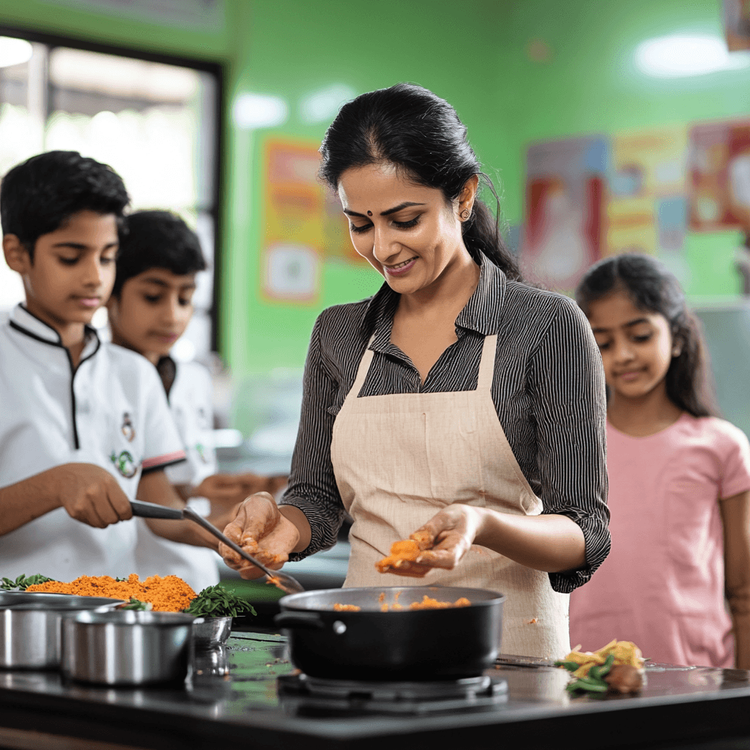Cooking in Schools: Why Every Student Should Learn to Cook

Table of Contents
Cooking is often relegated to home kitchens or private classes, but there’s a compelling case for integrating cooking lessons into school curricula. Cooking in school isn’t just about creating meals - it’s a life skill that can empower students, promote healthier choices, build confidence, and foster creativity. Let’s explore why cooking should be part of every child’s education.
1. Cooking Is a Practical Life Skill
In today’s fast-paced world, many people rely on ready-made meals, takeout, and processed foods. Learning to cook equips students with essential skills:
Financial literacy: Planning, budgeting, and shopping for ingredients teaches fiscal responsibility.
Independence: Adolescents gain self-reliance; they don't have to depend on others for meals.
Safety awareness: Understanding kitchen safety - andling knives, using heat sources - prevents accidents.
Nutritional knowledge: Students discover how ingredients impact their health and energy levels.
By teaching cooking in school, we prepare students to make informed, health-conscious decisions throughout their lives.
2. Supports Health and Wellness
Integrating cooking classes helps combat rising health issues among youth:
Obesity and chronic diseases: Hands-on cooking fosters appreciation for fresh foods, reducing processed ingredient consumption.
Better eating habits: Students exposed to cooking learn about balanced meals, portion control, and diverse nutrients.
Positive food psychology: Understanding how meals are made instills mindful eating habits.
When kids know how to prepare meals from scratch, they’re more likely to eat healthfully and advocate for better options at home.
3. Enhances Academic Learning
Cooking lessons support multiple academic disciplines:
Mathematics: Measuring, scaling recipes, and doubling portions reinforce fractions, ratios, and proportions.
Science: Chemical reactions in cooking - baking soda, caramelization, and food preservation techniques build scientific understanding.
Reading and comprehension: Following recipes boosts reading fluency and comprehension.
Cultural studies: International cuisines become windows into global traditions, geography, and history.
By connecting cooking to core subjects, educators create engaging, cross-curricular learning experiences.
4. Cultivates Creativity and Teamwork
Cooking is a creative endeavor that encourages experimentation:
Flavor exploration: Combining spices, seasoning, and contrasting textures builds sensory creativity.
Recipe invention: Encouraging variations inspires problem-solving and innovation.
Collaboration: Kitchen tasks teach time management, division of labor, and teamwork.
Presentation skills: Plating dishes helps students practice aesthetics and confidence.
These collective tasks also enhance social skills and group employment, soft skills essential in any profession.
5. Builds Character and Independence
Cooking isn’t easy - it teaches perseverance, patience, and responsibility:
Trial and error: Recipes may fail the first time. Learning from mistakes encourages grit.
Time investment: Successful meals require planning and attention to detail.
Ownership: Seeing a dish from start to table gives children a sense of accomplishment.
Cultural pride: Cooking family or ethnic recipes strengthens identity and appreciation for cultural heritage.
Overall, students who cook often develop greater self-confidence and agency.
6. Promotes Equity and Accessibility
When cooking classes are offered to all students, they help bridge socioeconomic gaps:
Universal access: All students learn essential life skills regardless of background.
Healthy options: Students without cooking experiences at home benefit - knowledge isn’t limited to those with kitchen support.
Food security lessons: Schools can incorporate lessons on budget cooking and food banks to address community needs.
Cooking education can level the playing field and contribute to long-term food independence.
7. Overcoming Common Challenges
Curriculum constraints
Many schools have limited time or focus on core subjects. Yet cooking lessons can be woven into existing subjects like science and health, or introduced after school.
Facility limitations
Not all schools have kitchens. Portable cooking stations or shared-use arrangements with cafeterias can help start programs on any budget.
Safety concerns
Certified instructors and clear safety protocols, with age-appropriate risks, can ensure a safe environment. Using induction hotplates and mock knives eliminates danger.
Funding issues
Grants, farm-to-school initiatives, or parent-led fundraising can secure resources. Cooking programs also support garden-to-table and sustainable-education goals.

8. How to Implement Cooking Classes in Schools
Start small with classroom-based cooking
Use simple recipes like fruit smoothies, vegetable wraps, or no-bake energy bars that require minimal equipment.
Use mobile cooking carts
Equip trolleys with portable burners, tools, and access to sinks for rotating classrooms.
Partner with cafeterias
Include kitchen time in vocational or home-ec courses, where students prepare school lunches or snacks.
Launch clubs and after-school programs
Cooking clubs can operate weekly, led by parents, staff, or community volunteers.
Host family cooking nights
Invite students and families to cook together - promotes community, health, and parental involvement.
Integrate subject-based lessons
Teach fractions with baking, nutrition with diet-planning lessons, or global cultures with international recipes.
Connect to experiential learning
Pair cooking with school gardens, visits from local chefs, kitchen field trips, livestock care, or sustainability projects.
9. Success Stories Across the Globe
United Kingdom: Many schools integrate cooking into PDHPE and life skills, improving students’ health and culinary knowledge.
Australia: Programs like the Stephanie Alexander Kitchen Garden Foundation teach cooking to thousands of students.
United States: Farm-to-school movements include real cooking experiences in districts, encouraging students to work with seasonal produce.
Kenya: Recipe clubs reduce malnutrition in schools by teaching nutritious local recipes.
These examples show how scalable and effective cooking education can be across contexts.
10. Why It Matters for the Future
Public health impact
Investing in children’s cooking skills leads to healthier generations and significant cost savings in healthcare.
Environmental sustainability
Understanding meal planning and food sourcing encourages less waste and more eco-friendly eating habits.
Economic empowerment
Skills in the kitchen can translate into entrepreneurship, food trucks, catering, and small food businesses.
Community resilience
Communities where cooking is common are better prepared during crises like pandemics or economic hardship.
11. A Call to Action
For educators: Consider adding cooking sessions - even monthly- to your teaching.
For administrators: Explore grants for portable cooking resources or partnerships with community groups.
For parents: Volunteer to support after-school cooking clubs or family-friendly kitchen events.
For communities: Partner with local chefs, nutritionists, farms, or stores to support educational cooking initiatives.
Teaching cooking equips students with lifelong benefits and strengthens a community’s health, resilience, and self-reliance.
12. Encouraging Cultural and Culinary Diversity
Cooking classes in school provide an excellent opportunity to celebrate diverse cultures. When students are asked to prepare dishes from different countries or regions, they learn about the cultural significance behind each dish. For instance:
Latin American empanadas teach about the ingredients native to Latin America.
Indian vegetable biryani introduces students to spices like turmeric, cardamom, and coriander while exploring their health benefits.
Japanese miso soup highlights fermentation and probiotics.
This diversity not only nurtures cultural tolerance but also broadens children's palates and supports inclusive learning environments. Participating in a multicultural cooking day can become an annual tradition, promoting unity and understanding in diversity.
13. Using Cooking to Teach Sustainability and Environmental Awareness
Cooking and food choices are deeply connected to the environment. Schools can integrate important lessons about sustainability through cooking initiatives:
Farm-to-table programs allow students to harvest fruits and vegetables from the school garden, promoting zero-mile food and reducing carbon emissions.
Waste-wise cooking emphasizes reducing food waste through composting leftover peels and planning meal portions.
Eco-friendly packaging can be taught by discussing plastic-free food storage and the importance of reusable containers.
Building an eco-conscious mindset in children helps them make environmentally responsible decisions - a trait that benefits both their well-being and the planet.
14. Building Entrepreneurial and Career Skills
Cooking school doesn't only prepare students for home life - it opens doors to potential career paths and entrepreneurial ventures:
Hospitality and culinary arts: Students can explore interests in cooking professionally through early exposure.
Food science and nutrition: Chemistry courses linked to cooking encourage students to explore scientific career opportunities.
Entrepreneurship: With practical skills in cooking and food presentation, students can test ideas like lemonade stands, bake sales, or food trucks, empowering confidence in business planning and communication.
By blending cooking with career exploration, schools create real-world applications for classroom learning.
15. Instilling Leadership and Responsibility
Group cooking challenges in school foster leadership skills:
Students rotate roles such as head-chef, sous-chef, and kitchen safety officer.
They coordinate meal planning, timing, and resource allocation.
They reflect on what went well and what could be improved - a practice that sharpens leadership awareness and collaboration skills.
Plating and presenting meals gives them confidence to speak and explain their creations to peers and parents.
These leadership opportunities help students learn accountability, respect for shared resources, and public speaking skills.
16. Strengthening Family and School Connections
When schools integrate cooking into their programs, families often get involved:
Family cooking nights let parents and children cook together, reinforcing learning at home.
Recipe-sharing events encourage families to bring a cultural favourite and explain its significance.
Cooking assignments, where students prepare something at home and share the process, deepen familial engagement.
These experiences strengthen relationships between schools and families by creating shared learning moments. They also allow parents to model healthy cooking habits.
17. Ensuring Inclusivity in Cooking Education
To make cooking lessons inclusive, schools should:
Provide allergy-sensitive options and alternatives.
Offer vegetarian, vegan, gluten-free, and dairy-free alternatives when planning menus.
Use adaptive tools to accommodate students with physical limitations.
Create batch lessons for students with reading or linguistic challenges, allowing them to work together with peers.
Ensuring inclusivity allows cooking to be accessible, empowering, and safe for every student. To know more, try Planetspark's creative writing course.
18. Measuring Impact and Success
How do we know cooking initiatives are effective? Schools can track success through:
Nutrition surveys to monitor students’ food choices over time.
Academic performance comparison in subjects like math, science, and language.
Behavioral surveys to see if students develop better table manners, discipline, or interest in healthy foods.
Participation rates in cooking-related clubs, competitions, or family cooking nights.
Student reflections and journaling help capture personal growth in confidence, empathy, and life skills.
Data collected this way provides compelling evidence that cooking enriches both academic and emotional development.
19. Sustainability and Scaling
To sustain cooking programs long-term, schools can:
Integrate cooking modules into USDA or government-funded nutrition programs.
Build partnerships with local farms, culinary institutes, or restaurants for mentorship and ingredient donations.
Create school cooperatives where families contribute time, produce, or fundraise together.
Use cooking events as community fundraisers to reinvest in equipment or garden spaces.
By embedding these programs into the school community, cooking becomes a sustainable, celebrated part of student life.
Conclusion
Cooking education should not be seen as an extracurricular indulgence - it's fundamental. By teaching students how to cook, schools provide essential tools for health, independence, creativity, and community. Culinary education nourishes both body and mind, preparing a responsibly fed, empathetic, and skills-fluent generation ready to tackle future challenges.
Every student deserves the right to stand in a kitchen, learn to measure, chop, season, and plate - not just as a lesson but as a life takeaway that continues beyond school walls.
Conclusion
Cooking should not be optional - it should be foundational in school education. Teaching children how to cook empowers them with essential life skills, supports their academic growth, and nurtures better health and creativity. By integrating cooking into schools - through portable carts, kitchen partnerships, after-school clubs, and interdisciplinary lessons -every student gains a meaningful advantage.
Cooking in school is more than preparing meals- it’s about preparing students for life. It empowers them with independence, nutrition knowledge, teamwork, creativity, and confidence. Let’s take cooking out of homes and kitchens and bring it into classrooms - because every child deserves the skills to nourish themselves and others.
FAQs:
How do you organise a successful cooking class?
Ans. Plan the class in advance. Select recipes that allow for more hands-on prep time. Include clean-up in the lesson. Focus on one or two new skills every class. Lastly, remember to have fun and make the cooking process joyful.Should students be taught cooking at school?
Ans. The opinion varies from one person to another. Some argue that it is an essential skill and helps students develop different life lessons. Children who learn cooking at school know more about a healthy diet and eat consciously. However, it can also be risky with all the techniques involved, and requires teaching staff to take the necessary precautions.
What healthy habits can children learn by cooking?
Ans. Cooking helps children explore their senses. When you bake, kids can hear the mixer's sound, watch the dough rise, smell the bread, and taste freshly baked bread from the oven. Children also become more responsible. From handling kitchen equipment safely and following a recipe to cleaning the spills and arranging things back in place, children get ample opportunities to learn responsibility.
Are there any benefits of learning to cook in school?
Ans. Yes. When children learn how to cook, they learn life skills through practising basic math skills like weighing, counting, tracking time, and measuring. It involves all of their senses as they cut, smell, pour, toss, knead, and feel foods. They also learn social skills by working together and communicating with each other.
Personalized Communication Report
Record a video to get a AI generated personalized communication report for your child

Hi There, want to try these
tips for your child with
LIVE with our expert coach?
Let's check your child's
English fluency
